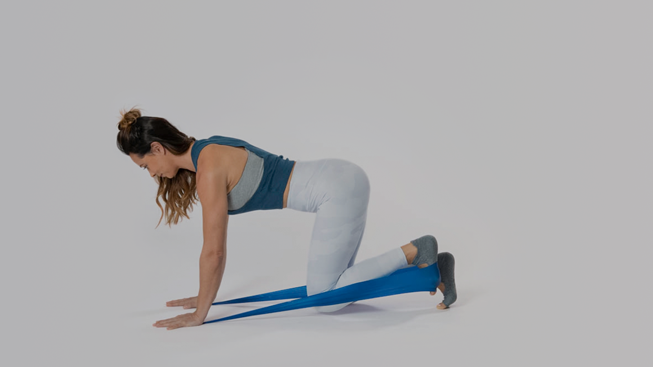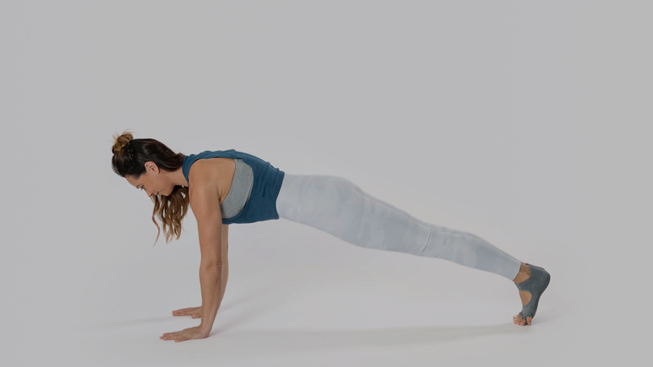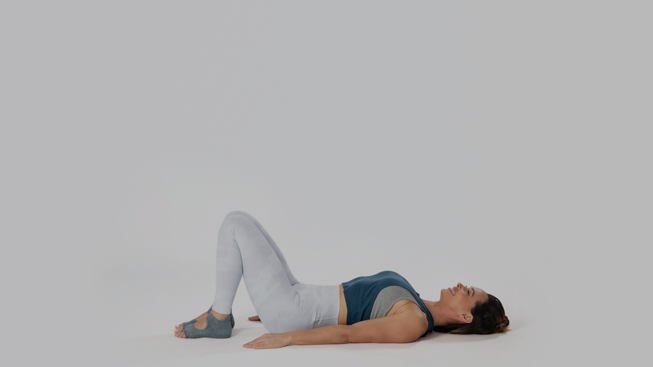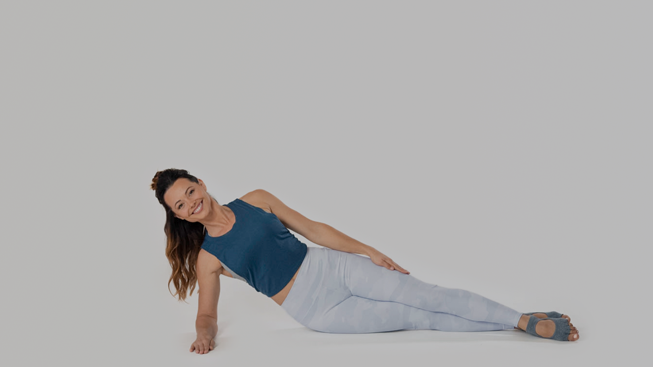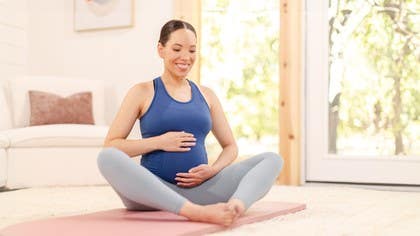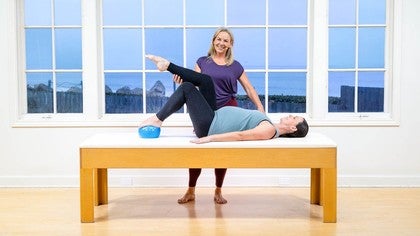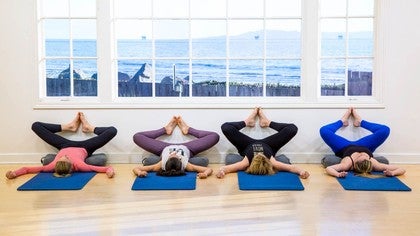Prenatal Pilates in the First Trimester
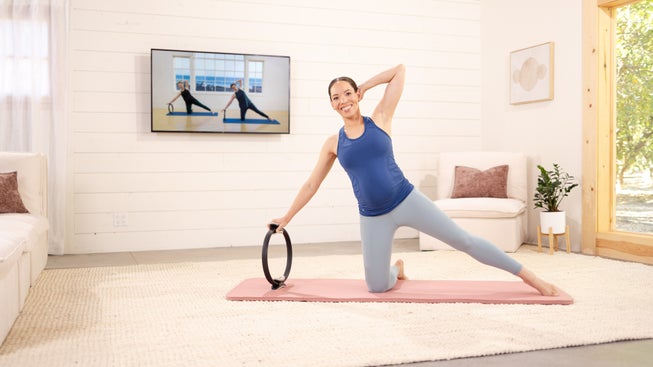
About Pilates in the First Trimester
Although you may not be showing, you’re likely beginning to feel pregnant. As you experience the new hormonal changes to your body, you may begin to feel fatigued and nauseous, perhaps with a decreased sense of balance, endurance, and coordination. The goal of prenatal Pilates is to help counteract these issues.
What are the benefits of Pilates during the first trimester?
In addition to strengthening and conditioning the entire body, prenatal Pilates can help counterbalance some of the issues that come up during pregnancy in a safe, gentle manner. For example, posterior work (e.g., glute strengthening) is emphasized to prevent any postural problems that might surface due to the weight of your growing bump. The breath taught in Pilates oxygenates and energizes the body, while serving as a tool to better cope with the emotional ups and downs that prenatal women might experience.
Is Pilates safe during the first trimester?
Yes! But the first trimester is not the time to push your body, nor is it a time to try to advance in your Pilates practice. Instead, the focus should be on your Pilates foundation, like breathing and stabilization. Only do as much (or as little) exercise as you feel comfortable doing. It’s important to pay attention to how you’re feeling and start to become more in tune with the needs of your body on any given day. Pilates workouts can be easily adapted to accommodate the prenatal body and how an expectant woman is feeling from day to day. If your back is feeling a little sore, for example, or your chest tight, there are modifications that can be made.
Prenatal Pilates Exercises (First Trimester)
Single Leg Press
Single Leg Press
This Single Leg Press will engage your hamstrings and shoulder stabilizers while you move in this quadruped position. Repeat on each side.
Plank with Leg Lift
Plank with Leg Lift
You will work your entire body with this Plank variation. Adding the Leg Lift will give an extra challenge to your core. Repeat on each side.
Single Leg Bridge
Single Leg Bridge
This Single Leg Bridge will work your hamstrings and glutes while opening the front of your body. Repeat on each side.
Side Bend
Side Bend
Strengthen your obliques and challenge your stability with this Side Bend exercise. Repeat on each side.
Exercises to Try in the First Trimester
Reformer Pilates is an excellent way to safely challenge the body during the first trimester, since the spring tension can support the body against gravity. The elevated surface of the Reformer—and the other apparati, such as the Cadillac—is helpful for prenatal women who might find it difficult to lie down on a mat. (Due to increased blood volume in your body during pregnancy, you may find yourself prone to dizziness.) Prenatal Pilates Mat exercises are another safe, effective way to exercise during this time. If you find yourself experiencing fatigue, you can reduce your pace but still get the benefits of a boost in core strength and stability.
Exercises to Avoid in the First Trimester
Although the Reformer can be a supportive way to work the entire body, Reformer Pilates needs to be introduced in an appropriate way. If you’ve never done Pilates, it’s important to learn the movements and body mechanics before adding the challenge of resistance. If you’re already comfortable on the Reformer, it’s recommended for moms-to-be to opt for a heavier spring tension during stability exercises and to go lighter during leg or arm work. The good news is that there are no specific exercises that are off limits during the first trimester. Now is a great time to find a teacher who can educate you on how to stay safe and prepare for your second trimester.
Precautions and Modifications
Although all of the exercises in Pilates, on both the Mat and on the equipment, are technically safe to perform during the first trimester, in general it’s important to take care not to overexert or overheat your body, two no-nos during pregnancy. In addition to slowing down and taking breaks when needed, paying attention to your range of motion during Pilates is important for safety. Avoid overstretching, since the ligaments of the pregnant body are more sensitive. To keep things within a safe range, support props, such as a Stability Ball or Foam Roller, especially during rotation, can be helpful.
Our Advice
Above all, never ignore your body. If you’re feeling exhausted or slow-moving, don’t push yourself. Sometimes a good old-fashioned nap is more important than exercise! Pregnancy is not the time to focus on moving up a level or advancing in your Pilates practice. Work at your own pace, choosing exercises that make you feel good. Don’t feel the need to work out for a full hour if you’re not up for it. The good news is that with Pilates, a little goes a long way.
Top 5 Pilates Exercises to Do While Pregnant
Frequently Asked Questions
What other types of exercises are recommended during the first trimester?
Aside from Pilates, which is one of the best workouts for pregnancy, you should feel free to do whatever movement you enjoy as long as you’re listening to your body and working at a pace that aligns with how you’re feeling.
Can Pilates help relieve common pain issues during the first trimester?
Yes! The deep breathing and movement in Pilates oxygenates the body and increases circulation, which boosts energy and promotes rejuvenation. The strength and stability you’ll develop on the Reformer and on the Mat will keep your body pain free as your belly expands.
What if Pilates is causing pain or discomfort?
Slow down! It’s important to listen to your body and move at your own pace during pregnancy. If needed, consult a Pilates instructor for guidance.
Should I warm up before a Pilates session?
A well-crafted Pilates session or class will always feature a built-in warm-up and cool-down, so you’re covered! If you’re working out on your own, start slow, easing into the workout, and finish off with some gentle movements.
Related Articles
Your Pilates Anytime Membership Benefits
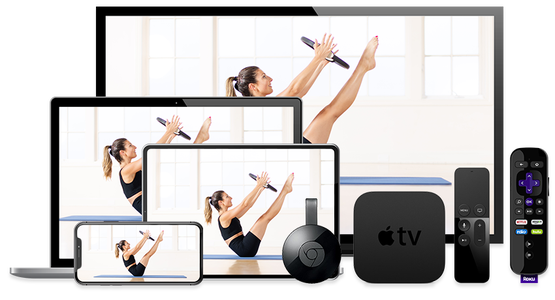
- 15-Day Free Trial
- Unlimited Access to Thousands of Classes
- 95+ Pilates Programs and Challenges
- No Ads
- New Videos Weekly
- Available on All Your Favorite Devices
